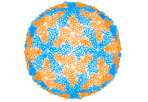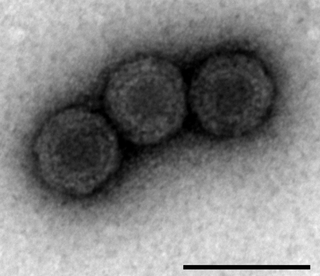
Sedoreoviridae is a family of double-stranded RNA viruses. Member viruses have a wide host range, including vertebrates, invertebrates, plants, protists and fungi. They lack lipid envelopes and package their segmented genome within multi-layered capsids. Lack of a lipid envelope has allowed three-dimensional structures of these large complex viruses to be obtained, revealing a structural and likely evolutionary relationship to the cystovirus family of bacteriophage. There are currently 97 species in this family, divided among 15 genera in two subfamilies. Reoviruses can affect the gastrointestinal system and respiratory tract. The name "reo-" is an acronym for "respiratory enteric orphan" viruses. The term "orphan virus" refers to the fact that some of these viruses have been observed not associated with any known disease. Even though viruses in the family Reoviridae have more recently been identified with various diseases, the original name is still used.

Orbivirus is a genus of double-stranded RNA viruses in the family Reoviridae and subfamily Sedoreovirinae. Unlike other reoviruses, orbiviruses are arboviruses. They can infect and replicate within a wide range of arthropod and vertebrate hosts. Orbiviruses are named after their characteristic doughnut-shaped capsomers.

Orthoreovirus is a genus of viruses, in the family Reoviridae, in the subfamily Spinareovirinae. Vertebrates serve as natural hosts. There are ten species in this genus. Diseases associated with this genus include mild upper respiratory tract disease, gastroenteritis, and biliary atresia. Mammalian orthoreovirus 3 induces cell death preferentially in transformed cells and therefore displays inherent oncolytic properties.
Fiji disease virus (FDV) belongs to the reoviridae family and infects plants. It is one of the few plant viruses in the Reoviridae family. The type species of the genus Fijivirus, it is the only known member of Fijivirus group 1.

Coltivirus is a genus of viruses that infects vertebrates and invertebrates. It includes the causative agent of Colorado tick fever. Colorado tick fever virus can cause a fever, chills, headache, photophobia, myalgia, arthralgia, and lethargy. Children, in particular, may develop a hemorrhagic disease. Leukopenia with both lymphocytes and neutrophils is very common for Colorado tick fever virus. In either case, the infection can lead to encephalitis or meningitis.

Double-stranded RNA viruses are a polyphyletic group of viruses that have double-stranded genomes made of ribonucleic acid. The double-stranded genome is used as a template by the viral RNA-dependent RNA polymerase (RdRp) to transcribe a positive-strand RNA functioning as messenger RNA (mRNA) for the host cell's ribosomes, which translate it into viral proteins. The positive-strand RNA can also be replicated by the RdRp to create a new double-stranded viral genome.

Banna virus (BAV) is a virus belonging to Reoviridae, a family of segmented, non-enveloped, double-stranded RNA viruses. It is an arbovirus, being primarily transmitted to humans from the bite of infected mosquitoes of the genus Culex. Pigs and cattle have also been shown to become infected. The most common symptom of infection is fever, but in some cases encephalitis may occur. There is no specific treatment for infection, so treatment is aimed at alleviating the severity of symptoms until the immune system has cleared the infection.

Seadornavirus is a genus of viruses, in the family Reoviridae, in the subfamily Sedoreovirinae. Human, cattle, pig, and mosquitoes serve as natural hosts. There are three species in this genus: Banna virus (BAV), Kadipiro virus and Liao ning virus. Each of these viruses has been isolated from Aedes, Anopheles and Culex mosquito populations, but only BAV has been shown to cause infection in humans, in which the symptoms are similar to Japanese encephalitis—fever, malaise and encephalitis. The word seadornavirus is an portmanteau, meaning Southeast Asian dodeca RNA virus.
Liao ning virus (LNV) is a virus belonging to the genus Seadornavirus within the family Reoviridae, a family of segmented, non-enveloped, double-stranded RNA viruses. LNV was first discovered in Aedes dorsalis populations in the Liaoning province of the People's Republic of China in 2006 from mosquito samples obtained in 1997. Its geographic distribution was previously thought to be limited to China, but it has since been found in mosquito populations in Australia. In addition to Aedes dorsalis, LNV has been isolated from Culex species.

Sedoreovirinae was a subfamily of the Reoviridae family of viruses. Viruses in this subfamily are distinguished by the absence of a turreted protein on the inner capsid to produce a smooth surface.
Kadipiro virus (KDV) is a member of the virus family Reoviridae. It is an arbovirus and has been isolated from Culex, Anopheles, Armigeres, and Aedes mosquitoes in Indonesia and China. Other members of the genus Seadornavirus have been linked to viral encephalitis.

Aquareovirus is a genus of double-stranded RNA viruses in the family Reoviridae and subfamily Spinareovirinae. Fish, shellfish, and crustacean species serve as natural hosts. Aquareoviruses in general have low or no pathogenicity for fish. However, some cause hemorrhagic disease, hepatitis and pancreatitis. Grass carp hemorrhage virus is the most pathogenic aquareovirus. There are seven species in this genus.

Dinovernavirus is a genus of double-stranded RNA viruses in the family Reoviridae and subfamily Spinareovirinae. Member viruses replicate in a variety of mosquito cell lines. The name is an abbreviation for double-stranded, insect, novem, rna virus. There is one species in the genus: Aedes pseudoscutellaris reovirus.
Mimoreovirus is a genus of viruses, in the family Reoviridae, in the subfamily Sedoreovirinae. The only isolate infects the marine photosynthetic protist Micromonas pusilla, a prasinophyte. There is only one species in this genus: Micromonas pusilla reovirus.
Lubombo virus (LUBV) is an orbivirus that infects vertebrates and culicine mosquitoes, thought to be its arthropod vector. It is classified in the genus Orbivirus and the family Reoviridae. It is studied at biosafety level 2.
Eyach virus (EYAV) is a viral infection in the Reoviridae family transmitted by a tick vector. It has been isolated from Ixodes ricinus and I. ventalloi ticks in Europe.

Middelburg virus (MIDV) is an alphavirus of the Old World Group that has likely endemic and zoonotic potential. It is of the viral family Togaviridae. It was isolated from mosquitos in 1957 in South Africa, MDIV antigens have now been found in livestock, horses, and humans.
Umatilla virus(UMAV) is a dsRNA virus in the family Reoviridae, subfamily Sedoreovirinae, and the genus Orbivirus. This arbovirus was first isolated in 1969 in Umatilla County, Oregon in a group of Culex pipiens mosquitoes. The viral host is the Passer domesticus bird with the vectors being Culex mosquitoes.
Mammalian orthoreovirus (MRV) is a double-stranded RNA virus. It is a part of the family Reoviridae, as well as the subfamily Spinareovirinae. As seen in the name, the Mammalian Ortheoreovirus infects numerous mammalian species and vertebrates which serve as natural hosts. Some diseases that occur as a result of this virus or are associated with this virus include mild upper respiratory illness, and gastrointestinal illness. Examples of these are: upper respiratory tract syndromes, gastroenteritis, biliary atresia, obstructive hydrocephalus, jaundice, alopecia, conjunctivitis, and ‘oily hair’ associated with steatorrhea.

Piscine orthoreovirus (PRV) is a species in the genus Orthoreovirus that infects fish exclusively, PRV was first discovered in 2010 in farmed Atlantic salmon exhibiting Heart and Skeletal Muscle Inflammation (HSMI) and has been found present at higher concentration in fish with various diseases. These diseases include HSMI, jaundice syndrome, proliferative darkening syndrome and erythrocytic body inclusion syndrome. PRV is thought to mainly affect aquacultured and maricultured fish stocks, and recent research has been focused around the susceptibility of wild stock. However, whether PRV is virulent with respect to HSMI remains a topic of debate. PRV has been in the public eye mostly due to a potential linkage to farmed Atlantic Salmon exhibiting HSMI. Public concern has been raised regarding the possibility of open ocean-net farms transmitting PRV to wild salmon populations and being a factor in declining populations. PRV has not been confirmed to be pathogenic in wild salmon stocks.











